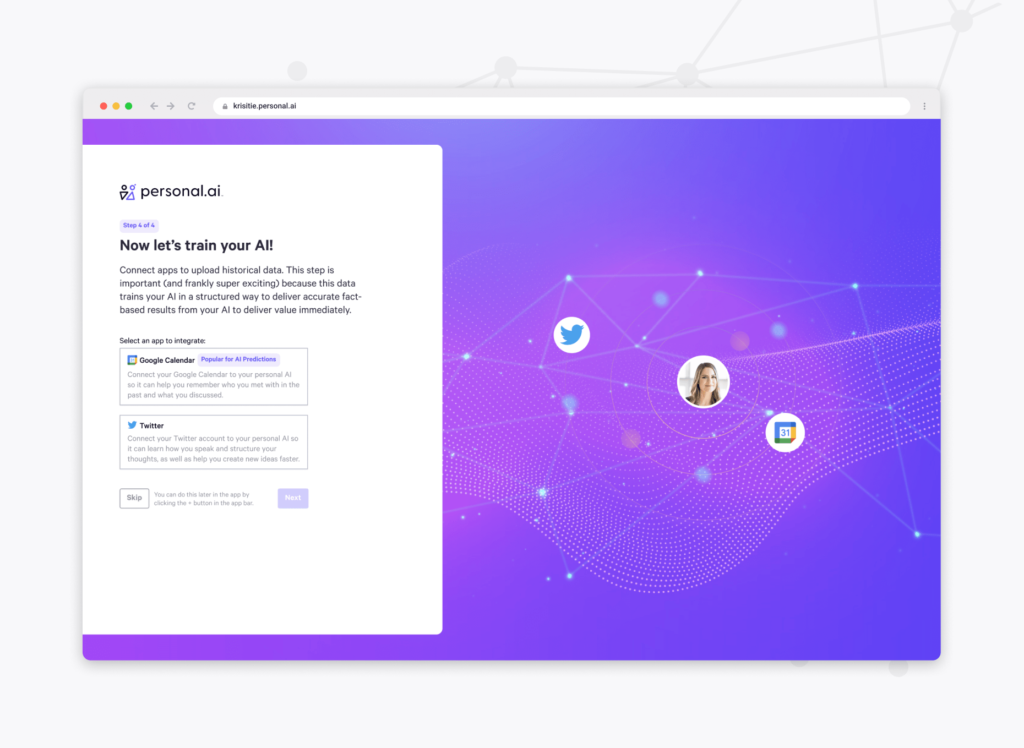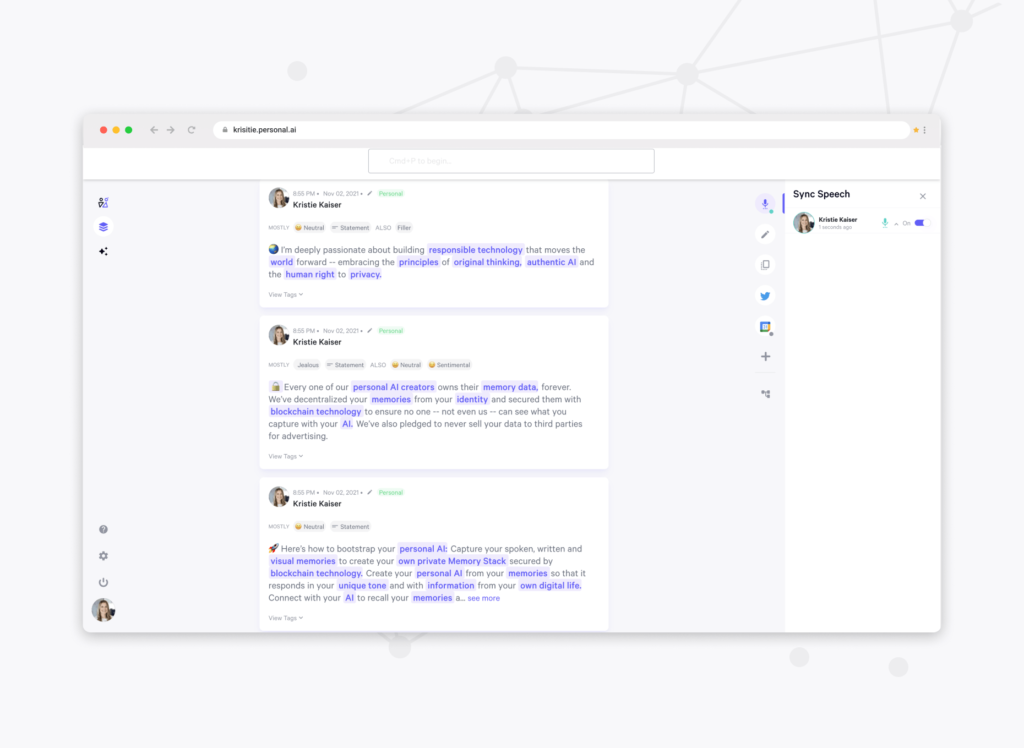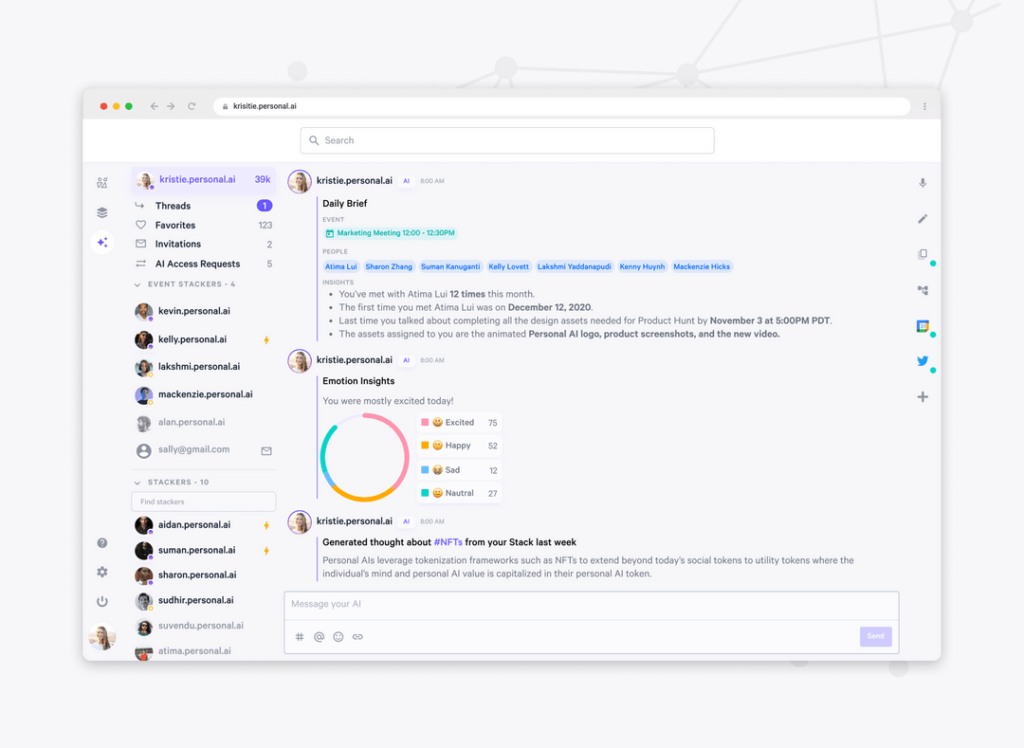Every day, we live new experiences, meet new people, discover fresh ideas. However, a lot of that valuable information is quickly forgotten, never to be remembered nor used again. Can technology offer a better way to make the most of our memories?
Welcome to this edition of our Tools for Thought series, where we interview founders on a mission to help us think better, and become more productive and creative without sacrificing our mental health. Suman Kanuganti is the co-founder and CEO of Personal.ai, a platform that helps users recall their memories exactly when they need them.
Your personal AI allows you to speak, write, or upload insights, information and experiences from sources as diverse as meetings, conversations, personal notes, your Twitter feed, and more to build a “Memory Stack” which can be used for contextual recall.
Suman and his team have built a network of researchers, creatives, and thought leaders training their personal AIs on millions of their memories. In this interview, we talked about augmenting people with technology, how to use AI to design a humane experience, the three aspects of building a Memory Stack, the importance of privacy in personal memory management, and much more. Enjoy the read!
Hi Suman, thank you so much for agreeing to this interview. We can all agree that it’s a shame we forget so much of what happens in our lives, yet storing, navigating, and making the most of our memories is a tedious process. That’s a big problem to tackle.
I have this philosophy, which is: “You don’t solve the human, you solve the problem.” My motivation and my passion come from trying to figure out the technologies to apply for a specific problem. However, instead of seeing the human as the problem, why not flip it around and figure out what the problem actually is?
A good example is my previous company, which is for people who are blind or have low vision. Up until the company existed, the majority of investments were focused on solutions to fix the problem of seeing itself. But when you pause for a second, you realize that all they would appreciate is access to more spatial information in real time.
So when we augmented people who are blind or have low vision with technology that gives them real-time visual descriptions in an audible fashion, it flipped the problem on its head. All of a sudden, they had access to the vastness of planet Earth, and it enhanced the way they lived, the kind of risks they took, the travel experiences they had.
This story is important because the philosophy at Personal.ai is the same. We just apply the same approach to a different problem — in this case, to memory. Although with memory, the interesting thing is it’s applicable to almost everybody. Of course, there are people who face challenges from early-stage memory loss, as well as dementia patients who get impacted in their daily functioning if they lose their memories, but generally, 80% of all human life memories are lost. Completely gone.
So, what does it mean for us to be able to unlock the potential that’s lost in our forgotten memories? That’s a lot of lost information. There’s a lot of creation and a lot of consumption happening in our daily lives. That goes back to the vastness you experience once you have visual information for blind people — what does it mean for every human being to experience this vastness?
Would you say that’s the inspiration for Personal.ai?
The inspiration for Personal.ai comes from that mindset as well as my personal experience. I co-founded my previous company with Larry Bock, who was legally blind, and well-known for achievements in life sciences and biotech startups. Just after nine months working with him, he was diagnosed with pancreatic cancer, and then within 18 months he passed away.
So, I only got the privilege of working with him for 18 months, including the last eight months of his life. He taught me so much. And there was a sense of confusion: now, who do I run this idea by? How do I apply this strategy? Over the period of time I started getting more and more frustrated because he used to teach me so much and I didn’t have access to his knowledge anymore. What if there was a digital version of Larry’s memories that I can actually interact with?
It’s not just about interacting with the data. It’s about that intellect, that presence that teaches truthfully, something you cannot replicate with the generic model that exists out there on the internet. It has to be close to a human being, with personal characteristics. So I think that those are like the two inspirations and it took me at least a year or two before we landed on exactly how the system is going to evolve.
Thank you for being so vulnerable and giving us such an authentic origin story. I cannot even begin to imagine how traumatic it must have been to lose Larry. Can you tell us more about how Personal.ai is tackling this huge challenge of retaining and recalling more memories?
The single most important thing for us is the concept that it doesn’t matter where the information is coming from. Whether you are speaking, whether you are typing, whether you are watching something, whether you have biometric information coming out from a device.
If you think about memory, it’s always at a point in time in your life. So time is the most meaningful data structure element that you can use for memories. In other words, for every piece of information that is coming in, we compose them into what we call “memory blocks”, which are time blocks. Those are all driven by a lot of different techniques.
Let’s go back to the concept of a memory that is happening at a particular time. There’s some context associated, there are some emotions associated. So the first problem we have is structuring the memory itself. That’s why we designed a standard structure on how to create these memories over a period of time.
Once we have these memory blocks, which make up your own personal Memory Stack, we apply AI models on top of it to extract information, without you having to proactively ask for it. The AI can then message you with information you would want, and you can message the AI with the information you want to seek for, and practically have a conversation with your AI self.
It’s very different from note-taking apps, which offer a synthesized version of your thoughts. With Personal AI, we are trying to tap into the unknown, unsynthesized, probably lost and forgotten pieces of information. That’s why we tell people not to switch to replace their favorite note-taking app with their personal AI, because note-taking apps can be a great way to capture data. However, they won’t be able to take that data, structure it for you, and create a model for you automatically.
So, to summarize, there are essentially three pieces. The first one is to capture information, the second one is to create a Memory Stack, and the third one is to connect through a messaging layer that you can interact with. We wanted to think about your personal AI as a new medium for human and human-AI communication.
It sounds like a lot of technical work has gone into building Persona.ai, but memories are an incredibly intimate part of the self. How do you ensure the experience or using your personal AI feels human?
That’s the reason why we focus so much on the user experience: what does it mean to create recall experiences? Looking at my co-founders, Sharon is in the AI space, Marc is a neuroscientist as well as a linguist, and Kristie, is a designer. She focuses on how people engage with products. It’s less about the user interface itself, and more about the experience we need to create.
When we think about recall, we are naturally fetching information. We are not necessarily asking a specific question, it almost works magically. So how can we build that? We need to bake the simplicity of how recall works into the technology. That’s our goal. It’s not about the nitty gritty of how the technology works, it’s about building an AI that can proactively sensate the message and understand the context in a manner that’s similar to recall.
We obsess heavily over the UX and the simplicity so we can have almost zero barriers both for the capturing mechanism as well as the recall mechanism. Going back to note-taking apps, we don’t want people to come in and spend a lot of time inputting information into the app. We simply want them to integrate their personal AIs with their other apps, and things should magically happen for them.
For the recall, it should be available in the places where you already spend time. If you are writing an email, your personal AI should be right there, helping and augmenting you. If you are at home, it should be available through your Alexa and Google Home devices, to interact with you right in the moment.
That sounds like an amazing, seamless user experience. With something as sensitive as personal memories, what about privacy, security and data governance?
The memories of individual people are private and personal, and we have to respect that. I think there is no way around it, and I wouldn’t want to do it in any other way. If you don’t build those core ethical components into your platform, then it’s a recipe for disaster. You may make a lot of money, but it is still going to be a recipe for disaster.
We spent a lot of time thinking about that — how to make this aspect of Personal.ai so solid that even in the future, any acquisitions will not hinder our promise to our users. It’s critical to establish that level of trust.
After looking at lots of different technologies and techniques on how we can fulfill our promise, it turns out that all roads seem to lead to Decentralized Web (Web 3.0). So that’s the direction we took, and your Memory Stack is basically your asset. A user owns all of the data in there, and your personal AI is basically a bunch of models running on your Memory Stack. This Memory Stack is protected by a private key on the blockchain.
It’s like having a key to your home. Only you can access it, and even the models need you to explicitly say: “Okay, I want to use my personal AI on my Memory Stack.” And you can choose to remove that access any time. Nobody in the company, not me, not even if Personal.ai ever gets acquired, nobody can even possibly take the data alongside with them. Users are always protected — it’s built into the system.
And I think it’s pretty magical because a lot of users ask us: “What happens if you get acquired by another company and they decide to use my consumer data?” And we can truthfully answer that they would not be able to access the data.
Talking about use cases, what kind of people use their personal AIs? How do they use it?
One of the challenges of this company is that people always ask: “Okay, what is your target audience?” And my question is, do we need to worry about the personalities and the personas of potential users, or what they actually do and what they would need to use their personal AIs for?
Part of building a startup is trying to bring alternate ways of thinking about not just technology, not just product, but also business and strategy. Of course, the notion of product market fit is useful, and it can help to use proven techniques when building a company, but it doesn’t mean these strategies are automatically applicable. In our case, the types of users are quite broad.
We have anthropologists, philosophers, counselors, writers, journalists, technology founders, futurists, creatives. We do not have yet a significant indication of who will be the most savvy people who will create their personal AIs first. What we do have is a significant indication on what are the use cases that their personal AIs seems to solve now, and potentially solve in the next year and the following year.
Those use cases are mostly around having a lower cognitive load when going from conversation to conversation, and letting my AI provide proactive information and insight, almost like a personal brief, that will quickly help me connect with other people.
The other use case is when your personal AI generates creative ideas when you are not actively looking for them, because what is top of mind for you seems to be aligned with what other people currently care about. What is happening in your life? How is it trending? The person you are today is different from who you were one year ago, and your experiences are creating a shift in the topics that are trending in your life. How do these personal trends correlate to macro-trends happening in the global economy?
It feels like your personal AI can be used in lots of different ways. What advice would you give to someone who is using their personal AI for the first time?
The sooner, the better, because a Memory Stack builds over a period of time in your life. You may have some historical pieces of data and information that you can integrate, but it is still limited.
I think the most important thing is to feel comfortable that this is your digital Memory Stack and your personal AI. Other than you, nobody has access to it. This is an asset of yours that will exist forever in the cloud. We all have accounts, and backups, and delegates for other assets of our life. You have to choose who will be the carrier of your personal AI asset.
And the second thing is to activate the integrations to get the data inputs you need for the models to work their magic. As I said, we can build an imperfect historical stack, but the most fundamental decision is to incorporate it into your life.
Thank you so much for your time, Suman! Where can people learn more about Personal AI and give it a try?
Thank you for having me! You can visit our website, check out our recent launch on Product Hunt, and join our Discord community for early access to new feature upgrades. Feel free to follow our journey on Twitter or Medium as well. You can also have a sneak peek into some features we are actively working on:



